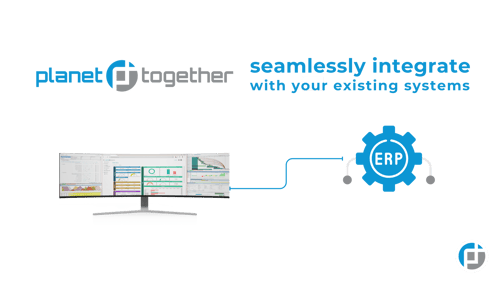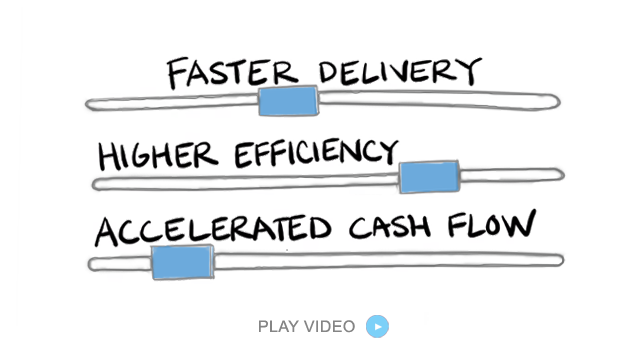Digitally Transforming the Industrial Manufacturing Supply Chain: What Supply Chain Managers Need to Know
In industrial manufacturing, “digital transformation” is no longer a buzzword—it’s a competitive imperative. Global supply chains have grown increasingly complex, and for supply chain managers, the stakes are higher than ever: deliver on time, keep costs down, minimize waste, and respond to rapid market shifts—all while juggling legacy systems and disconnected data.
So, how can supply chain managers keep up?
The answer lies in digitally transforming supply chain operations—and that transformation starts with integrating Advanced Planning and Scheduling (APS) solutions like PlanetTogether into your broader ERP ecosystem, whether that’s SAP, Oracle, Microsoft Dynamics, Kinaxis, or Aveva.
Let’s unpack how digital transformation is reshaping supply chains in industrial manufacturing and how you can harness it to stay competitive, agile, and future-ready.

Why Digital Transformation Matters More Than Ever
In industrial manufacturing, the supply chain is a living, breathing network that spans procurement, production, warehousing, distribution, and beyond. Disruptions—be it raw material shortages, geopolitical conflicts, or labor constraints—can cause ripple effects across the entire value chain.
Digital transformation helps mitigate these risks by enabling:
Real-time visibility into inventory, capacity, and customer demand.
Integrated planning across departments and systems.
Predictive analytics to identify potential bottlenecks or inefficiencies before they escalate.
Automated workflows that reduce manual errors and enhance speed.
At the heart of this transformation is the ability to bring disparate systems and processes together through integration.

The Power of Integration: PlanetTogether and ERP Systems
One of the biggest hurdles in digital transformation is disconnected systems. Most industrial manufacturers run core operations on ERPs like SAP, Oracle, Microsoft Dynamics, Kinaxis, or Aveva. While these platforms are powerful, they often fall short when it comes to advanced production planning and scheduling.
That’s where PlanetTogether APS comes in.
PlanetTogether provides robust, real-time scheduling capabilities that go beyond what traditional ERP systems offer. When integrated with your ERP, PlanetTogether helps you:
Optimize production schedules based on real-time capacity, labor, and materials availability.
Reduce lead times and improve delivery performance.
Minimize changeovers and increase equipment utilization.
Enhance cross-functional collaboration between planning, procurement, and operations.
Example: Integration with SAP
SAP is a global leader in ERP software, but its standard planning modules can struggle with high-mix, low-volume production environments. By integrating PlanetTogether with SAP, supply chain managers gain the ability to simulate multiple production scenarios, assess constraints instantly, and make data-driven scheduling decisions.
Example: Integration with Kinaxis
Kinaxis excels in supply chain planning and S&OP. When connected with PlanetTogether, manufacturers can link high-level planning with detailed scheduling. This means demand signals from Kinaxis can automatically inform production schedules in PlanetTogether, enabling faster response times and improved synchronization across the supply chain.
The same goes for integrations with Oracle, Microsoft Dynamics, and Aveva—each gaining enhanced planning accuracy and execution agility through PlanetTogether’s APS engine.

From Firefighting to Forecasting: Real Benefits for Supply Chain Managers
Supply chain managers often find themselves in firefighting mode—reacting to delays, expediting orders, and juggling conflicting priorities. Digital transformation through APS and ERP integration helps shift from reactive to proactive supply chain management.
Here are the tangible benefits:
Agility in Planning
Digitally transformed supply chains can adjust plans in near real-time. If a critical machine goes down or a shipment is delayed, PlanetTogether’s scheduling engine recalculates instantly, giving you updated schedules that reflect real-world conditions.
Scenario-Based Decision Making
Need to decide whether to run overtime, outsource production, or change shift patterns? PlanetTogether lets you run what-if scenarios based on data from your ERP system, helping you make informed tradeoffs before committing resources.
Inventory Optimization
With tighter integration between demand planning and production scheduling, companies can avoid overstocking or stockouts. You’ll carry just enough inventory to meet demand while freeing up working capital.
Improved On-Time Delivery
Better schedules mean fewer surprises. Integrated planning helps ensure the right product is manufactured at the right time—improving customer satisfaction and reducing penalties for late shipments.
Lower Operational Costs
By optimizing machine usage, labor allocation, and material flow, digital scheduling tools help reduce downtime, waste, and overtime costs—resulting in a leaner, more efficient supply chain.
A Roadmap for Supply Chain Managers: Getting Started
Digital transformation can feel overwhelming, but it doesn’t have to be. Here’s a practical roadmap for supply chain managers in industrial manufacturing:
Step 1: Assess Your Current State
Identify pain points in your current planning process. Are you still using spreadsheets for scheduling? Are changes communicated manually? Understand where gaps exist between planning and execution.
Step 2: Define Objectives
What are your top priorities—reducing lead times, improving delivery performance, increasing throughput? Set clear goals for what you want digital transformation to achieve.
Step 3: Choose the Right APS System
Select an APS platform like PlanetTogether that aligns with your production environment and supports seamless integration with your ERP system (SAP, Oracle, Microsoft, Kinaxis, Aveva).
Step 4: Plan the Integration
Work with your IT and operations teams to ensure a smooth integration. PlanetTogether has pre-built connectors and APIs for common ERP systems, which reduces the time and complexity involved.
Step 5: Train and Collaborate
Digital tools are only as good as the people using them. Train your team to interpret and act on data from the new system. Encourage collaboration across departments to break down silos.
Step 6: Monitor, Learn, and Improve
Once live, use dashboards and KPIs to track performance. Look for continuous improvement opportunities and refine your workflows over time.
Real-World Impact: A Case in Point
A mid-sized industrial manufacturer producing custom equipment for the energy sector recently integrated PlanetTogether with Microsoft Dynamics 365. Before the integration, their planners manually updated production schedules weekly, leading to bottlenecks and missed delivery dates.
After implementing PlanetTogether:
Scheduling lead time dropped by 60%.
On-time delivery improved from 78% to 96%.
Production planners reported 50% less time spent rescheduling orders.
By connecting the APS with their ERP system, the company gained real-time visibility into capacity and could adjust production runs dynamically based on changes in demand or supply constraints. The transformation didn’t just boost performance—it empowered the supply chain team to lead with confidence.
Digital transformation isn’t about replacing your ERP—it’s about extending its value. As a supply chain manager, your role is pivotal in making that transformation a reality.
With the right tools and a strategic approach, you can shift from managing chaos to orchestrating excellence.
Are you ready to digitize your supply chain operations and move toward a smarter, more synchronized future? Explore how PlanetTogether integrates with your existing ERP platform to help you lead the next wave of transformation in industrial manufacturing. Contact us today to learn more about how PlanetTogether can help you achieve your goals and drive success in your industry.
Topics: Industrial Manufacturing, Inventory Optimization, PlanetTogether Software, Integrating PlanetTogether, Improved On-time Delivery Performance, Agility in Planning, Scenario-Based Decision Making





















LEAVE A COMMENT